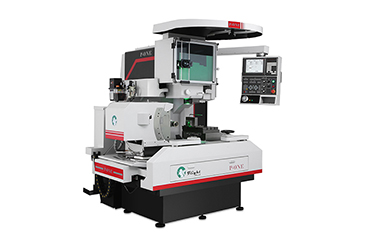

Operators must receive theoretical and practical training on optical curve grinding machines and pass the assessment to obtain the job qualification certificate before they can be qualified to operate.
I. Preparations before Processing
The operator must be familiar with the performance, processing range and precision of the machine tool in accordance with the machine tool's user manual, and be proficient in the functions and operation methods of the machine tool, its numerical control device and each part of the computer.
Check whether all the switches, knobs and handles are in the correct positions.
The electrical part of the start-up control shall be preheated as stipulated.
Start the machine tool and let it run idle. Check the sensitivity of each switch, button, knob and handle, as well as whether the lubrication system is normal, etc.
Be familiar with the processing program and programming origin of the workpiece to be processed.
The pulling results in the X and Y directions shall not exceed 2 μ m/100mm
Adjust the sample image so that the reference line of the sample image coincides with the reference line of the projector.
Adjust the up and down stroke of the grinding head so that the upper and lower limits of the stroke exceed the workpiece by 10mm. Optical curve grinding machine II. Clamping of grinding wheel and workpiece
Select the appropriate grinding wheel and avoid colliding with it. For steel materials with a hardness exceeding HRC65, diamond grinding wheels are selected, while for steel materials with a hardness below HRC65, CBN grinding wheels are chosen.
Generally, large-diameter grinding wheels are selected. When grinding small-diameter punch pins, small-diameter grinding wheels can be chosen.
During the finishing process, check the fillet radius of the grinding wheel and then write it into the compensation parameter table.
The workpiece clamping should be firm and reliable. Attention should be paid to avoiding interference between the tool and the work or between the tool and the worktable during operation.
Iii. Processing Requirements
Before conducting the first piece processing, it is necessary to go through steps such as program inspection (trial run program), trajectory inspection, single program segment trial cutting and dimension inspection, and select the appropriate feed rate. (Fine machining is available at 1mm/min, rough machining at 3mm/min)
During processing, the program must be input correctly and no unauthorized changes to the program are allowed. During processing, the feed rate per tool for semi-finishing is 8 microns, and for finishing it is 2 microns. During the processing, the operator should constantly monitor the display device. When an alarm signal is detected, the machine should be stopped promptly to eliminate the fault.
During processing, the control system must not be opened at will or the computer interrupted.
After the parts are processed, the program should be registered and kept for future use.
Record the origin coordinates before shutting down the machine.
This process is a key processing procedure. After the workpieces processed pass the self-inspection, they must be sent to the inspection department for special inspection.
The curve grinding machine is a type of processing machine tool, which consists of two parts: the main machine and the auxiliary machine station. The main machine is of a fully enclosed structure. On the right side of the machine body, there is a multi-functional worktable. On the left side, there is a grinding wheel frame and a slide seat. The upper part is a CCD detection device. The electrical cabinet is located at the rear of the main machine and is integrated with it. The auxiliary machine station is integrated with a dust collection device, a cooling device, an air balance and a brake control station.